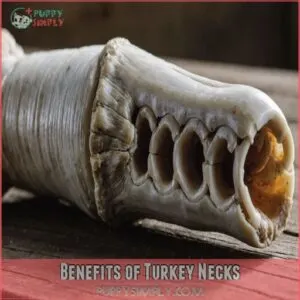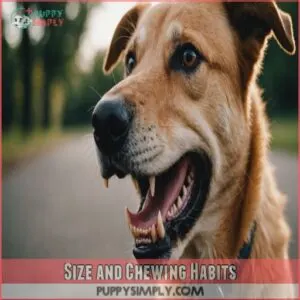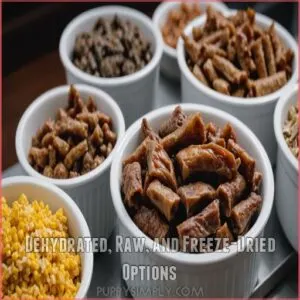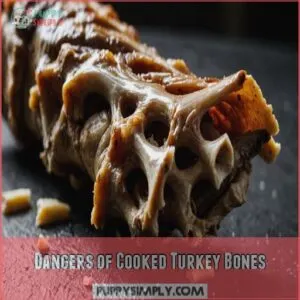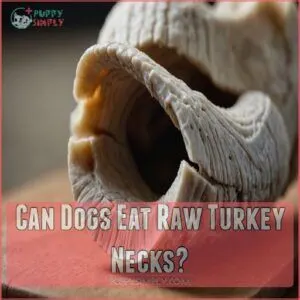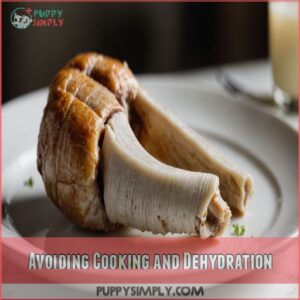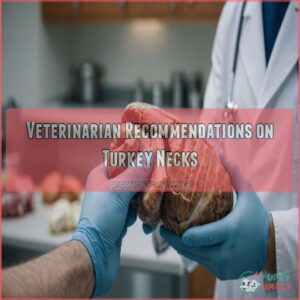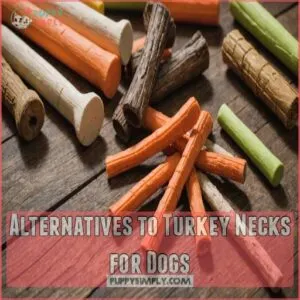This site is supported by our readers. We may earn a commission, at no cost to you, if you purchase through links.
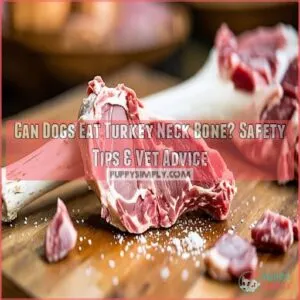 Can dogs eat turkey neck bone? Yes, but only if it’s raw.
Can dogs eat turkey neck bone? Yes, but only if it’s raw.
Raw turkey neck bones can be a nutritious treat, offering joint and dental health benefits.
They pack a punch with glucosamine, which supports your pup’s joints, and that crunchy texture helps clean their teeth.
However, remember the golden rule: never give cooked bones. Cooked turkey neck bones can splinter and cause serious injuries.
Always supervise your dog when they enjoy this chewy delight to prevent choking or digestive issues.
There’s more to learn about serving size and other alternatives, ensuring your furry friend stays both happy and healthy!
Table Of Contents
- Key Takeaways
- Benefits of Turkey Necks
- Drawbacks of Turkey Necks
- Choosing The Right Turkey Neck
- Feeding Turkey Necks Safely
- Dangers of Cooked Turkey Bones
- Can Dogs Eat Raw Turkey Necks?
- Preparing Turkey Necks for Safe Consumption
- Veterinarian Recommendations on Turkey Necks
- Alternatives to Turkey Necks for Dogs
- What to Do if Your Dog Eats a Turkey Bone
- Frequently Asked Questions (FAQs)
- Can dogs eat turkey neck bones?
- What meat should I never feed my dog if they have dementia?
- Can a dog eat raw turkey necks?
- Can dogs eat raw turkey bones?
- What happens if a dog eats a turkey neck?
- How many turkey necks can a dog eat?
- Which turkey bones are safe for dogs?
- Can my dog eat neck bones?
- Can my dog eat the turkey neck and giblets?
- What is turkey neck syndrome in dogs?
- How often can I give my dog turkey necks?
- Are turkey wings better than necks for dogs?
- Can I give my dog cooked turkey neck bones?
- My dog swallowed a bone whole; should I worry?
- What if my dog has allergies to turkey?
- Conclusion
Key Takeaways
- You can give your dog raw turkey neck bones to boost joint and dental health, but always supervise to prevent choking.
- Never feed cooked turkey neck bones, as they are also high in fat, increasing the risk of pancreatitis in dogs. They can splinter and cause serious internal injuries.
- Opt for raw or dehydrated turkey necks, considering your dog’s size and chewing habits to avoid digestive issues.
- When considering adding raw bones like turkey necks to your dog’s diet, it’s essential to understand the benefits and risks of a raw diet grain free dog food. Always consult your vet for personalized advice before introducing turkey necks into your dog’s diet.
Benefits of Turkey Necks
Feeding your dog turkey necks can greatly enhance their joint health and dental hygiene thanks to the natural presence of collagen, glucosamine, and chondroitin.
These necks also serve as a protein-rich treat that promotes muscle development and offers engaging mental and physical enrichment.
Joint Health
How can turkey necks improve your dog’s joint health? These tasty treats are packed with glucosamine and chondroitin, which promote cartilage health and arthritis relief. This helps increase mobility and comfort for your furry friend.
- Glucosamine & Chondroitin: Aid in joint repair and maintenance.
- Arthritis Relief: Naturally reduces symptoms.
- Mobility Support: Enhances overall movement.
Always consult your vet before adding new foods.
Dental Health
Turkey necks are a natural way to bolster your dog’s dental hygiene.
Chewing on these bones helps clean teeth, reducing plaque buildup and keeping those gums healthy.
It’s like a workout for their jaws without the treadmill!
Remember, they’re not just chewing benefits—they’re essential for dog teeth maintenance.
Here’s a quick comparison:
| Benefit | Description |
|---|---|
| Plaque Reduction | Natural scrubbing action |
| Gum Health | Encourages healthy gums |
| Jaw Exercise | Strengthens jaw muscles |
Enrichment
While cleaning teeth matters, turkey necks also offer great enrichment.
Chewing a turkey neck bone engages your dog’s brain and fights boredom, like mental gymnastics for dogs.
Try these for enrichment:
- Chew toys: Enhance with turkey necks.
- Puzzle feeders: Stimulate curiosity.
- Interactive games: Challenge with rewards.
- Training sessions: Incorporate safe bones.
These activities keep a dog’s mind sharp.
Muscle Development
Regarding Fido’s muscle development, raw turkey necks are a lean protein powerhouse.
Packed with essential nutrients, they fuel your dog’s exercise routine and support muscle growth.
By providing turkey neck bone dogs, you’re helping meet their protein needs while promoting joint support.
Keep in mind, monitoring your pet’s intake is key to maximizing these dog health benefits safely.
Mental and Physical Health
Beyond the physical perks, turkey necks offer significant mental and physical health benefits for your canine companion.
Think of them as a natural stress reducer; the chewing action provides mental stimulation, keeping your dog happily occupied.
Improved joint mobility and better coat health are added bonuses.
You’ll also notice increased energy levels and potentially better weight management.
It’s a win-win for both of you!
Drawbacks of Turkey Necks
When considering turkey necks for your dog, be aware of potential drawbacks like choking hazards and digestive issues if your pet swallows large pieces.
Raw turkey necks may also carry pathogens such as Salmonella, posing health risks that necessitate careful preparation and monitoring.
Choking and Constipation
Turkey necks carry a significant choking hazard, especially for dogs that gulp their food.
The risk isn’t just in swallowing; raw bone risks include constipation, turning your dog’s digestion into a waiting game.
Instead of raw bones, consider durable dog chew toys alternatives.
Make sure they chew safely by supervising them closely.
Consider turkey neck alternatives to keep your furry friend happy and healthy without the worry of intestinal blockages.
Esophageal or Intestinal Foreign Body
Choking and constipation are concerns, but there’s more to keep in mind.
Esophageal or intestinal blockages from turkey neck bones pose serious risks.
Symptoms might include vomiting or loss of appetite.
To prevent this, make sure your dog chews thoroughly.
- Diagnosis: Watch for unusual behavior.
- Treatment: Vet consultation may lead to surgery.
- Prevention: Supervise meals closely.
- Surgery: Sometimes necessary for removal.
Pathogens in Raw Meat
When feeding your dog raw turkey neck bones, it’s important to keep food safety in mind.
Raw meat can harbor pathogens like Salmonella, leading to bacteria concerns.
Proper meat storage and handling are key to parasite prevention.
Always supervise your pet with dog bones to minimize risks.
Pathogens in raw meat can compromise your dog’s health and digestion.
Digestive Issues
With turkey neck bone dog digestion, keep an eye out for symptoms like diarrhea, vomiting, or constipation.
These issues can turn your pup’s tummy upside-down, leading to bloating or discomfort.
If your dog’s sensitive to new foods, food allergies might flare up.
Always supervise a dog eating turkey neck bone to avoid potential digestion problems, especially when it comes to smoked turkey neck risks, ensuring their health stays in check.
Choosing The Right Turkey Neck
When choosing the right turkey neck for your dog, consider their size and chewing habits to make sure they’ve a safe and enjoyable treat.
Larger breeds may handle whole necks, while smaller or toy breeds could benefit from duck or chicken necks instead.
Size and Chewing Habits
Because a turkey neck’s size directly impacts your dog’s safety, careful consideration is key.
Matching bone size to your dog’s chewing strength prevents choking hazards.
Here’s what to keep in mind:
- Bone size: Choose appropriately.
- Chewing strength: Consider your dog’s breed.
- Swallowing speed: Observe your dog’s eating habits.
- Chewing habits: Does your dog crunch or gulp?
- Dog bone safety: Prioritize safe chewing options.
Smaller dogs need smaller bones; toy breeds might need alternatives altogether.
Breed and Weight Considerations
Selecting the right turkey neck depends on your dog’s size and breed.
Large dogs handle bigger, tougher necks with ease, while small and toy breeds might struggle.
For these petite pups, opt for smaller necks to suit their chew strength and digestive capacity.
Medium-sized dogs find a balance in turkey hen necks.
Always supervise to make sure safe chewing.
Dehydrated, Raw, and Freeze-Dried Options
After considering your dog’s breed and weight, deciding between dehydrated, raw, or freeze-dried options can enhance their diet.
Dehydrated turkey necks offer convenience and low mess, while raw provides natural nutrients.
Freeze-dried versions maintain nutritional integrity.
Each type has its benefits and drawbacks, so prepare wisely.
Always prioritize safe dog bone options to guarantee your pet’s health and happiness.
Feeding Turkey Necks Safely
To feed turkey necks safely, always choose raw or dehydrated options, as they are a natural source of glucosamine for joints, and supervise your dog during meals to prevent choking hazards.
Providing fresh water and offering them outside can also help maintain cleanliness and reduce the risk of bacterial contamination.
Only Feed Raw or Dehydrated Turkey Necks
When considering dog-safe bones, choose only raw or dehydrated turkey necks.
Cooking risks involve bone splintering, which can be a serious hazard.
Raw turkey necks lower the chance of splintering but watch out for bacteria contamination.
Dehydrated necks are a safer choice, preserving nutrients without cooking risks.
Make sure your furry friend chews properly to avoid choking hazards.
Feed Turkey Necks Outside
You’ve opted for raw or dehydrated turkey necks for your dog, so let’s make sure a clean feeding area is maintained.
Feeding outside helps prevent bacteria spread and keeps your floors tidy.
It also aligns with natural dog behavior, providing outdoor safety and reducing indoor messes.
Plus, it allows easy yard cleanup after your dog enjoys turkey neck bone digestion.
Feed by Hand if You Have a Gulper
Some dogs are gulpers, diving nose-first into their meals, barely pausing to chew.
For such eaters, hand-feeding turkey necks can be a game-changer.
It lets you control the pace, reducing the choking risk and promoting safe feeding habits.
This also helps your dog savor each bite, ensuring turkey neck bones are chewed properly for safe digestion and overall health.
Offer Frozen Turkey Necks to Slow Your Dog’s Feeding
Does your dog gobble food down in a flash?
A frozen turkey neck can be a lifesaver!
The frozen texture slows down even the fastest eaters, making it a safer, more enjoyable chew.
This helps prevent choking hazards and promotes better digestion.
It’s a simple trick for dog safety, turning a potential problem into a fun, healthy treat.
Remember, always supervise your furry friend while they enjoy their frozen turkey neck bone chew.
Provide Fresh Water
After letting your dog enjoy a frozen turkey neck to slow their feeding, don’t forget hydration.
Always have fresh water available for them.
Choose an appropriate water bowl size that suits your dog’s needs, and change it frequently to make sure water quality is good.
This keeps their digestion smooth and supports their overall turkey neck bone dog health and preferences.
Dangers of Cooked Turkey Bones
Cooked turkey bones can pose serious risks to your dog, as they’re prone to splintering and causing internal damage.
These bones can also lead to blockages and constipation, not to mention the potential for infections and food-borne illnesses.
Splintering and Internal Damage
Cooked turkey bones are dangerous for your dog.
They splinter easily, turning into sharp fragments that pose serious risks like internal bleeding and digestive issues.
Picture a bone fragment lodging in your dog’s throat—an emergency vet visit is likely.
Instead, consider safer alternatives, like bully sticks or dental chews, which offer similar benefits without the turkey neck bone dog risks.
Blockages and Constipation
Beneath a well-done exterior, cooked turkey bones can spell trouble for your dog, leading to blockages and constipation.
They can lodge in the intestines, causing severe discomfort or worse.
Cooked turkey bones can also splinter into sharp pieces, posing a serious risk to your dog’s internal health, as explained in can dogs eat turkey wing bones.
Keep an eye out for these key concerns:
- Signs of blockage: vomiting, lethargy, and refusal to eat.
- Prevention tips: avoid cooked bones.
- Vet advice: seek help immediately if you suspect your dog has ingested a cooked turkey bone.
Infections and Food-Borne Illnesses
When dealing with turkey bones, here’s a worry: cooked bones can cause blockages but also infections. These brittle bones splinter easily and may introduce harmful bacteria.
Raw vs. cooked, the risk remains as pathogens like Salmonella, E. Coli, Listeria, and Campylobacter can thrive.
Safe handling and prevention tips protect your dog’s health and safety, avoiding signs of illness.
Can Dogs Eat Raw Turkey Necks?
Feeding your dog raw turkey necks can be a nutritious choice, offering benefits like joint support and dental health.
However, it’s important to think about potential risks, including choking hazards and bacterial contamination, while ensuring supervision and moderation.
Benefits of Feeding Raw Turkey Necks
Let’s move on to the good stuff: raw turkey necks offer amazing benefits for your pup.
If you’re looking for a convenient source, you can find Raw Turkey Necks for Dogs online.
They’re a natural source of:
- Protein for strong muscles.
- Healthy chews for clean teeth.
- Nutrients for a shiny coat.
- Improved digestion.
Giving your dog raw turkey necks can be a great way to provide them with natural, healthy nutrition.
Remember, always supervise your furry friend while they enjoy their tasty treat!
Potential Risks of Raw Turkey Necks
Raw turkey necks may seem beneficial, but they carry potential risks.
Parasites and bacteria like Salmonella, Listeria, and E. Coli are concerns.
Bones could splinter, posing a choking hazard and causing digestive problems.
Stay cautious by considering these risks.
Here’s a quick breakdown:
| Risk | Outcome | Concern for Dogs |
|---|---|---|
| Parasite Risk | Illness | High |
| Bone Splintering | Injury | Significant |
| Bacteria Risk | Infection | Critical |
Prioritizing safety is key.
Importance of Supervision and Moderation
While raw turkey necks offer health perks, concerns about pathogens highlight that keeping a watchful eye is smart.
Supervise your dog’s snack time for these reasons:
- To reduce choking risks from bones.
- Make sure dog safe bones.
- Control frequency to avoid overfeeding.
- Monitor digestion changes.
Your presence guarantees turkey neck bone safety!
Preparing Turkey Necks for Safe Consumption
To ensure your dog derives the benefits of turkey necks, including their joint and mobility benefits, start by removing bones and cartilage, then cut the neck into smaller, manageable pieces.
Avoid cooking or dehydrating them, as these methods can increase the risk of splintering and potential harm.
Removing Bones and Cartilage
Curious about raw turkey necks?
Removing bones and cartilage can make them safer for your pup, but beware that even raw turkey necks, if not properly prepared, can lead to internal injuries if splintering occurs.
Use bone removal techniques to minimize risks, turning turkey neck bone into a dog-safe delight.
Focus on cartilage safety to prevent digestion concerns.
Homemade options abound, but professional help guarantees turkey bone dog safety, avoiding dog bone choking hazards in your pooch’s turkey feast.
Cutting Into Smaller Pieces
Let’s talk about cutting turkey necks into smaller pieces for your dog’s safety.
It helps prevent choking and aids digestion.
Here’s how to prepare them:
- Use a sharp knife to slice small, manageable pieces.
- Watch out for Gulpers; smaller bites are easier to chew.
- Monitor your dog closely while eating.
- Ensure digestion with smaller, safer amounts.
Avoiding Cooking and Dehydration
After cutting turkey necks into smaller pieces, consider the preparation method.
Avoid cooking them, as this makes bones brittle and dangerous for your dog.
Instead, opt for raw or safely dehydrated options, which maintain nutritional value without risking splintering.
Always think about bone safety and possible foodborne illnesses to make sure turkey neck bone dog digestion is safe and healthy.
Veterinarian Recommendations on Turkey Necks
Before giving your dog turkey necks, it’s always best to chat with your vet, especially if your pup has any digestive issues or is a puppy or senior dog.
They can offer personalized advice on whether turkey necks are a good fit for your furry friend’s diet and health needs.
Advice for Puppies and Dogs With Digestive Issues
Puppies and dogs with digestive issues need cautious feeding.
A balanced nutrient profile, including key nutrients like fiber and probiotics that promote healthy digestion, is essential for their overall gut health Learn more about puppy food for digestive health.
Turkey neck bones, while dog-safe for many, mightn’t suit those with sensitive stomachs.
Such bones can cause digestive risks, leading to discomfort.
Consider your puppy’s diet carefully.
Monitor them for any food allergies and prioritize their gut health.
Always consult with your vet about safe options for your furry friend.
Importance of Moderation and Consultation
Moderation is key to safe feeding when offering turkey neck bones to your dog.
They may support dog health, but overfeeding can lead to digestion problems.
Always consult your vet for specific advice on bone size and frequency.
Their guidance makes sure turkey necks remain dog-safe and promotes healthy digestion.
Remember, every dog is unique; trust expert advice for their well-being.
Balancing Diet and Nutrition
Thinking about balancing your dog’s diet with turkey necks? Vet recommendations emphasize moderation and variety. You can find a variety of turkey neck chews online at websites like Turkey Neck Products.
Here’s a quick guide:
- Treats: Use turkey necks as occasional rewards, not staples.
- Supplements: Consider vitamin-rich options alongside raw turkey necks.
- Commercial Foods: Balance fresh additions like turkey necks with complete dog food to meet nutritional needs effectively.
Alternatives to Turkey Necks for Dogs
If you’re looking for safe chewing options besides turkey necks, consider bully sticks, chicken feet, or salmon skins.
Carrots and apples are also great choices that can add variety to your dog’s diet while promoting dental health.
Bully Sticks
Bully sticks provide a great alternative to turkey necks, offering a safer chewing option for dogs.
They’re made from high-quality beef, ensuring both safety and high protein content.
Unlike turkey bones, bully sticks are less likely to splinter, reducing choking hazards, which is especially important considering the potential risks associated with turkey neck choking hazards.
Different sizes cater to your dog’s needs.
Ultimately, they serve as a reliable dog bone alternative.
Chicken Feet
When considering alternatives, chicken feet are a crunchy option.
They’re not just safe; they offer several perks:
- Chicken feet benefits: Rich in glucosamine, aiding joint health.
- Chicken feet safety: Raw or dehydrated best prevents splintering.
- Chicken feet preparation: Make sure they’re clean before serving.
- Chicken feet for small dogs: Ideal size for smaller breeds.
Explore these as a potential replacement for turkey necks.
Salmon Skins
So, you’ve considered chicken feet?
Another great option is salmon skins! They’re packed with Omega-3 benefits and offer nutritional value.
However, always make sure to prepare them safely; thoroughly clean them to avoid risks and precautions.
Remember, moderation is key with any treat. Like turkey necks for dogs, which provide essential nutrients like trace minerals and vitamins, salmon skins should be part of a balanced diet.
Always supervise your pup while they enjoy their tasty snack.
Many dog bone alternatives exist; find what works best for your furry friend.
Carrots and Apples
Not all snacks need to be gnawed-on turkey neck bones.
Consider carrots and apples as dog-safe snacks and healthy treats.
Carrots support dental health and are low in calories, making them a wonderful treat alternative.
Apples offer fiber and vitamins while still being a pleasant choice.
They’re a simple solution to keep your furry friend delighted without digestive worries.
What to Do if Your Dog Eats a Turkey Bone
If your dog gobbled up a turkey bone, it’s important to act quickly and assess the situation for any signs of distress like choking or discomfort.
In serious cases, you should contact your vet immediately to discuss potential risks and necessary steps for ensuring your furry friend’s safety.
Choking Hazards and First Aid
What should you do if your dog gobbles up a turkey bone?
First, check for choking signs like coughing or gagging.
Second, attempt the Heimlich maneuver if your pup struggles to breathe.
Finally, make sure your emergency vet’s number is on speed dial.
Remember, bones can cause choking hazards and even an esophageal foreign body, leading to severe veterinary emergencies.
Digestive Blockages and Emergency Care
If your dog devours a turkey bone, worry kicks in.
Watch for signs of blockage like vomiting, abdominal pain, or trouble pooing.
As a precaution, it’s important to note that turkey necks can cause digestive issues, including constipation or intestinal obstruction, especially if not consumed safely, see Turkey Neck Risks.
An X-ray diagnosis may reveal an esophageal foreign body or intestinal blockages.
Surgery options exist, but quick veterinary care is necessary to prevent emergencies.
Home remedies might help, yet vet advice is important to ensure safety and control.
Preventing Future Incidents and Accidents
To prevent future incidents with your curious canine and turkey bones, always supervise feeding times closely.
Opt for dog bone alternatives like bully sticks, ensuring safe chewing experiences.
Monitor the size of bones—big enough to chew well but not swallow whole.
Petproofing your kitchen and storing turkey necks safely can minimize accidents.
These steps boost dog safety and peace of mind.
Frequently Asked Questions (FAQs)
Can dogs eat turkey neck bones?
Dogs can eat turkey neck bones when raw, as they provide nutrients and benefits like joint support and teeth cleaning.
Always supervise your dog during feeding to prevent choking.
Consult your vet for specific guidance.
What meat should I never feed my dog if they have dementia?
You might wonder, what’s a no-go for dogs with dementia?
Avoid feeding them processed meats like sausages and ham.
These contain high fat and sodium levels, which can worsen cognitive issues.
Opt for simple, nutritious foods instead.
Can a dog eat raw turkey necks?
Raw turkey necks can be a nutritious treat for your dog, providing protein and minerals like calcium.
Raw turkey necks can be a nutritious treat for your dog, providing protein and minerals like calcium.
However, always supervise to prevent choking hazards or bacterial risks.
It’s wise to consult your vet before introducing them.
Can dogs eat raw turkey bones?
Choosing the right pet diet is like walking a tightrope.
Raw turkey bones can be safe but watch for choking or digestive troubles.
Supervise your dog during meals, keep bones raw, and consult your vet for the best advice.
What happens if a dog eats a turkey neck?
If your dog eats a turkey neck, it can benefit from protein and nutrients, like calcium and B vitamins, supporting joint and dental health.
However, there’s a risk of choking or digestive issues, especially without supervision.
How many turkey necks can a dog eat?
Dogs chew 40% of bones more efficiently.
Feed one turkey neck weekly per 10-20 pounds of dog’s weight.
Monitor digestion closely, ensuring no choking or digestive issues arise.
Always consult your vet before changing their diet.
Which turkey bones are safe for dogs?
Raw turkey necks are okay, but cooked ones are a no-go. Cooked bones splinter, posing a choking hazard. Always supervise your pup, and choose appropriately sized necks for their breed.
Can my dog eat neck bones?
Your dog can eat raw turkey neck bones, but always supervise their chewing.
These necks offer nutrition and dental benefits.
Avoid cooked bones, as they splinter.
Make sure your pup chews thoroughly to prevent choking hazards.
Can my dog eat the turkey neck and giblets?
Imagining your dog devouring Thanksgiving dinner is cute, but only feed raw or cooked giblets, never cooked bones which splinter.
Supervise munching to avoid choking.
Check with your vet if your dog has health issues beforehand.
What is turkey neck syndrome in dogs?
Turkey neck syndrome in dogs isn’t a medical term.
It might refer to the drooping skin of older dogs, or a hypothetical condition.
Always consult your vet if you notice unusual symptoms or behaviors in your dog.
How often can I give my dog turkey necks?
Ever wonder how often you can give your dog turkey necks?
Give them once or twice a week under supervision.
Make sure they chew properly, and always monitor their reaction to make sure they digest it well and stay healthy.
Are turkey wings better than necks for dogs?
Choosing between turkey wings and necks for your dog depends on size and chewing habits.
Turkey necks are often better for joint health due to glucosamine content.
Wings might be better for larger breeds needing firmer bones.
Can I give my dog cooked turkey neck bones?
Cooked turkey neck bones aren’t safe for your dog.
They’re brittle and can splinter, which poses choking hazards or causes serious injuries.
Stick to raw, dehydrated options instead to guarantee your furry friend’s safety while snacking.
My dog swallowed a bone whole; should I worry?
That’s a worry! Monitor your dog closely for choking or digestive issues. If you see distress, contact your vet immediately. They can advise on the best course of action.
What if my dog has allergies to turkey?
If turkey’s a red flag for allergies in your pup, consider alternatives like duck or fish.
Consult your vet before introducing new proteins.
Monitoring your dog’s reaction guarantees safety and helps tailor their diet for good health.
Conclusion
Choosing the right dog treats can feel like walking a tightrope, especially when pondering, "Can dogs eat turkey neck bone?"
Yes, they can—if raw.
Raw turkey necks offer joint and dental benefits while engaging your dog’s mental and physical health.
However, heed the risks: cooked bones can be dangerous.
Choose the right size, prepare with care, and consult your vet.
Many alternatives exist, ensuring your furry friend gets both tasty and safe nutrition.

